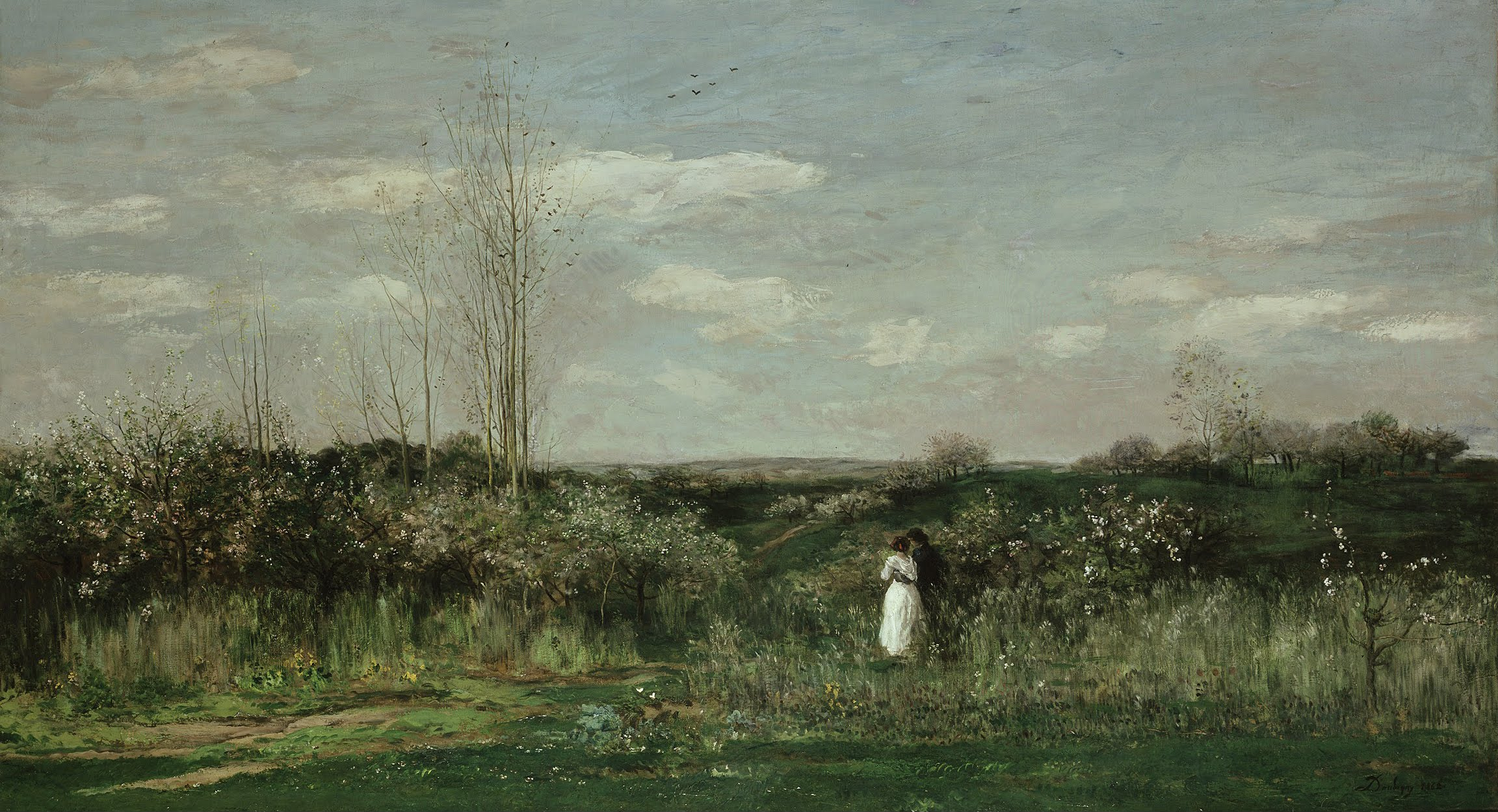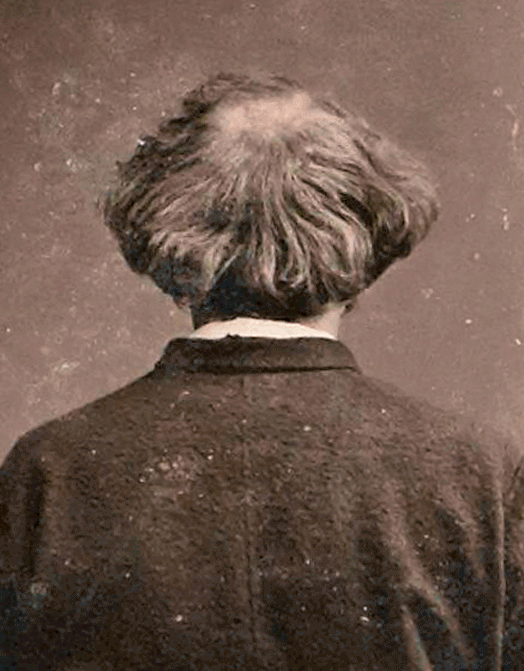|
Charles-François Daubigny
Charles-François Daubigny ( , , ; 15 February 181719 February 1878) was a French painter, one of the members of the Barbizon school, and is considered an important precursor of impressionism. He was also a prolific printmaker, mostly in etching but also as one of the main artists to use the cliché verre technique. Biography Daubigny was born in Paris, into a family of painters; taught the art by his father, , and his uncle, miniaturist Pierre Daubigny (1793-1858). He was also a pupil of Jean-Victor Bertin, Jacques Raymond Brascassat and Paul Delaroche, from whom he would quickly emancipate himself. In 1838, he set up, at the Rue des Amandiers-Popincourt, a community of artists, a phalanstery, with Adolphe-Victor Geoffroy-Dechaume, Hippolyte Lavoignat, Ernest Meissonnier, Auguste Steinheil, Louis Joseph Trimolet, with whom he already had expressed his interest in subjects drawn directly from daily life and nature. These artists will work, among others, for the publisher Léon ... [...More Info...] [...Related Items...] OR: [Wikipedia] [Google] [Baidu] |
Nadar
Gaspard-Félix Tournachon (5 April 1820 – 20 March 1910), known by the pseudonym Nadar, was a French photographer, caricaturist, journalist, novelist, balloon (aircraft), balloonist, and proponent of Aircraft#Heavier-than-air – aerodynes, heavier-than-air flight. In 1858, he became the first person to take aerial photographs. Photographic portraits by Nadar are held by many of the great national collections of photographs. His son, Paul Nadar (1856–1939), continued the studio after his death. Life Gaspard-Félix Tournachon (also known as Nadar) was born in early April 1820 in Paris, though some sources state he was born in Lyon. His father, Victor Tournachon, was a printer and bookseller. Nadar began to study medicine but quit for economic reasons after his father's death. Nadar started working as a caricaturist and novelist for various newspapers. He fell in with the Parisian bohemian group of Gérard de Nerval, Charles Baudelaire, and Théodore de Banville. His friends ... [...More Info...] [...Related Items...] OR: [Wikipedia] [Google] [Baidu] |
Seine
) , mouth_location = Le Havre/Honfleur , mouth_coordinates = , mouth_elevation = , progression = , river_system = Seine basin , basin_size = , tributaries_left = Yonne, Loing, Eure, Risle , tributaries_right = Ource, Aube, Marne, Oise, Epte The Seine ( , ) is a river in northern France. Its drainage basin is in the Paris Basin (a geological relative lowland) covering most of northern France. It rises at Source-Seine, northwest of Dijon in northeastern France in the Langres plateau, flowing through Paris and into the English Channel at Le Havre (and Honfleur on the left bank). It is navigable by ocean-going vessels as far as Rouen, from the sea. Over 60 percent of its length, as far as Burgundy, is negotiable by large barges and most tour boats, and nearly its whole length is available for recreational boating; excursion boats offer sightseeing tours of the river banks in the capital city, Paris. There are 37 bridges in P ... [...More Info...] [...Related Items...] OR: [Wikipedia] [Google] [Baidu] |
Portugal
Portugal, officially the Portuguese Republic ( pt, República Portuguesa, links=yes ), is a country whose mainland is located on the Iberian Peninsula of Southwestern Europe, and whose territory also includes the Atlantic archipelagos of the Azores and Madeira. It features the westernmost point in continental Europe, and its Iberian portion is bordered to the west and south by the Atlantic Ocean and to the north and east by Spain, the sole country to have a land border with Portugal. Its two archipelagos form two autonomous regions with their own regional governments. Lisbon is the capital and largest city by population. Portugal is the oldest continuously existing nation state on the Iberian Peninsula and one of the oldest in Europe, its territory having been continuously settled, invaded and fought over since prehistoric times. It was inhabited by pre-Celtic and Celtic peoples who had contact with Phoenicians and Ancient Greek traders, it was ruled by the Ro ... [...More Info...] [...Related Items...] OR: [Wikipedia] [Google] [Baidu] |
Barbizon School
The Barbizon school of painters were part of an art movement towards Realism in art, which arose in the context of the dominant Romantic Movement of the time. The Barbizon school was active roughly from 1830 through 1870. It takes its name from the village of Barbizon, France, on the edge of the Forest of Fontainebleau, where many of the artists gathered. Most of their works were landscape painting, but several of them also painted landscapes with farmworkers, and genre scenes of village life. Some of the most prominent features of this school are its tonal qualities, color, loose brushwork, and softness of form. The leaders of the Barbizon school were: Théodore Rousseau, Charles-François Daubigny, Jules Dupré, Constant Troyon, Charles Jacque, and Narcisse Virgilio Díaz. Jean-François Millet lived in Barbizon from 1849, but his interest in figures with a landscape backdrop sets him rather apart from the others. Jean-Baptiste-Camille Corot was the earliest on the scen ... [...More Info...] [...Related Items...] OR: [Wikipedia] [Google] [Baidu] |
Pierre Emmanuel Damoye
Pierre Emmanuel Damoye (20 February 1847 – 23 January 1916) was French artist who was regularly recognized by a broad range of art critics as one of the most significant heirs to the Barbizon school tradition. He studied his craft at the École des Beaux-Arts and went on to become a renowned and influential landscape artist noted for his sweeping skies, tree studded-plains, and vibrant farmlands. Teachers & Influences Damoye studied at the École des Beaux-Arts in the studio of Léon Bonnat, one of the foremost figure painters and portraitists of the late nineteenth-century. Damoye, however, seems to have committed himself to landscape art from the beginning of his career. His earliest dated works from the late 1860s also clearly reveal the influence of both Jean-Baptiste-Camille Corot and Charles-François Daubigny, from whom he acquired both a brighter range of colors and a looser, more ‘impressionist’ brush style. And, although he was cognizant of the example of Corot ... [...More Info...] [...Related Items...] OR: [Wikipedia] [Google] [Baidu] |
Albert Charpin
Albert Charpin, born in Grasse, Alpes-Maritimes in 1842, died in Asnières-sur-Seine in 1924. He was a naturalist painter associated with the Barbizon school. He painted real objects in a natural setting. A pupil of Charles-François Daubigny, Charpin was a painter of natural landscapes with, typically, a shepherdess and her guardian-dog taking care of animals, cows or sheep. Characteristic of his paintings are the natural poses and serenity of his actors, in a context of early morning light, with cloudy skies. He was a well-known member of the Barbizon School. One of his paintings, "Le Retour à la Ferme", is at the Musée des Beaux-Arts at Chambéry Chambéry (, , ; Arpitan: ''Chambèri'') is the prefecture of the Savoie department in the Auvergne-Rhône-Alpes region of eastern France. The population of the commune of Chambéry was 58,917 as of 2019, while the population of the Chamb ... in Savoie. His paintings can also found in museums and private collections e ... [...More Info...] [...Related Items...] OR: [Wikipedia] [Google] [Baidu] |
Hippolyte Camille Delpy
Hippolyte Camille Delpy (1842–1910) was a French painter. He came from a moderately wealthy family from Joigny, in the Burgundy region of France. His son, (1877–1957), also became a painter, as did a cousin on his father's side, (1898–1967). Delpy studied with Charles-François Daubigny as well as Corot. A contemporary of the Impressionists, Delpy blended the subject matter that he adopted from Daubigny with the brighter colors and looser paint handling that were trademarks of his own generation to create distinctive new visions of many of the landscapes first explored by the Barbizon artists. Delpy became interested in painting when he met Daubigny around 1855, and in 1858 Daubigny took on Delpy as an informal student. During the summers, Delpy (who was close in age to Daubigny's own son, Karl, also a painter) traveled with Daubigny on excursions aboard the studio-boat "Le Botin". Through Daubigny, Delpy met Corot, who encouraged and occasionally advised the young pai ... [...More Info...] [...Related Items...] OR: [Wikipedia] [Google] [Baidu] |
Paul Cézanne
Paul Cézanne ( , , ; ; 19 January 1839 – 22 October 1906) was a French artist and Post-Impressionism, Post-Impressionist painter whose work laid the foundations of the transition from the 19th-century conception of artistic endeavour to a new and radically different world of art in the 20th century. Cézanne is said to have formed the bridge between late 19th-century Impressionism and the early 20th century's new line of artistic enquiry, Cubism. While his early works are still influenced by Romanticism – such as the murals in the Bastide du Jas de Bouffan, Jas de Bouffan country house – and Realism, he arrived at a new pictorial language through intensive examination of Impressionist forms of expression. He gave up the use of Perspective (graphical), perspective and broke with the established rules of Academic Art and strived for a renewal of traditional design methods on the basis of the impressionistic color space and color modulation principles. Cézanne's often re ... [...More Info...] [...Related Items...] OR: [Wikipedia] [Google] [Baidu] |
Claude Monet
Oscar-Claude Monet (, , ; 14 November 1840 – 5 December 1926) was a French painter and founder of impressionist painting who is seen as a key precursor to modernism, especially in his attempts to paint nature as he perceived it. During his long career, he was the most consistent and prolific practitioner of impressionism's philosophy of expressing one's perceptions before nature, especially as applied to ''plein air'' (outdoor) landscape painting. The term "Impressionism" is derived from the title of his painting '' Impression, soleil levant'', exhibited in the 1874 ("exhibition of rejects") initiated by Monet and his associates as an alternative to the Salon. Monet was raised in Le Havre, Normandy, and became interested in the outdoors and drawing from an early age. Although his mother, Louise-Justine Aubrée Monet, supported his ambitions to be a painter, his father, Claude-Adolphe, disapproved and wanted him to pursue a career in business. He was very close to his mot ... [...More Info...] [...Related Items...] OR: [Wikipedia] [Google] [Baidu] |
London
London is the capital and largest city of England and the United Kingdom, with a population of just under 9 million. It stands on the River Thames in south-east England at the head of a estuary down to the North Sea, and has been a major settlement for two millennia. The City of London, its ancient core and financial centre, was founded by the Romans as '' Londinium'' and retains its medieval boundaries.See also: Independent city § National capitals The City of Westminster, to the west of the City of London, has for centuries hosted the national government and parliament. Since the 19th century, the name "London" has also referred to the metropolis around this core, historically split between the counties of Middlesex, Essex, Surrey, Kent, and Hertfordshire, which largely comprises Greater London, governed by the Greater London Authority.The Greater London Authority consists of the Mayor of London and the London Assembly. The London Mayor is distinguished fr ... [...More Info...] [...Related Items...] OR: [Wikipedia] [Google] [Baidu] |






